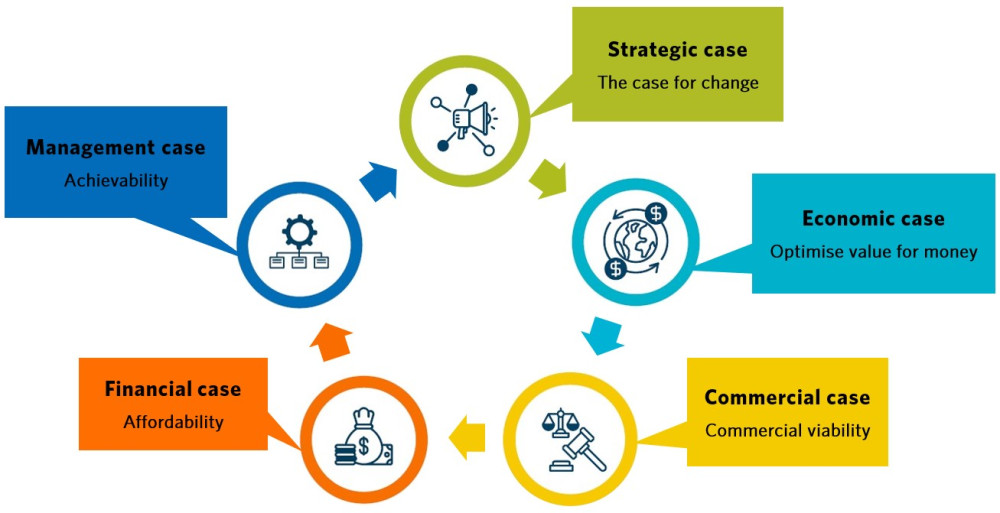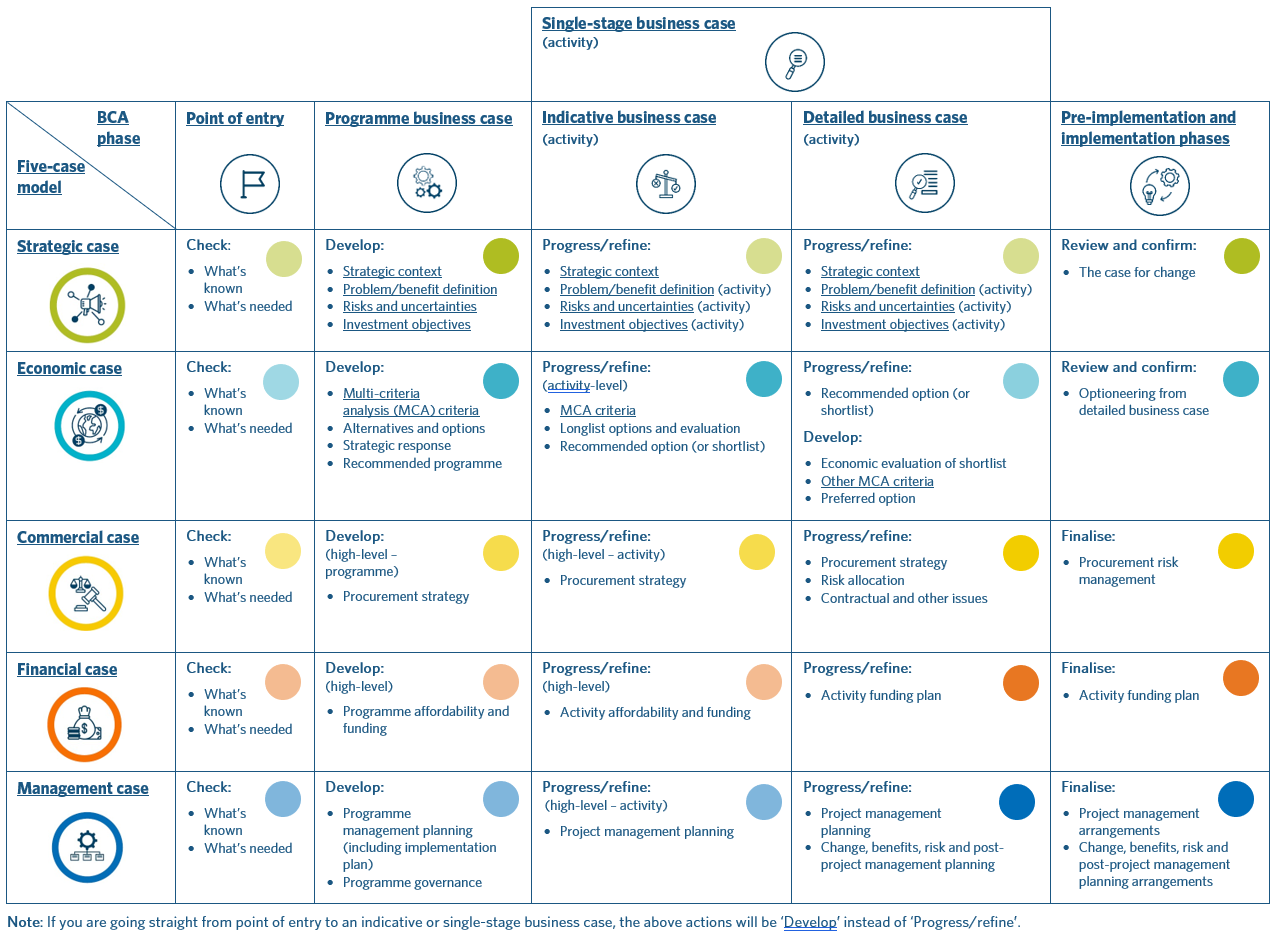![]() Learn more about the five-case model online
Learn more about the five-case model online
You can learn more about the five-case model through our interactive, online BCA essentials learning module. This module includes activities to help you understand and apply the five-case model..
The NZ Transport Agency Waka Kotahi (NZTA) Business Case Approach (BCA) is designed around the five-case model. This model has been adopted by the G20 as an international best practice standard for investment in infrastructure projects. It is also the basis of NZ Treasury’s Better Business Cases (BBC) framework.
The five-case model provides an effective framework around which a business case is progressively developed. Using the five-case model gives assurance to decision-makers and stakeholders that the business case has asked – and addressed – the right questions to ensure public value is optimised.
The five-case model is organised around five key dimensions.

The five-case model
The five-case model asks five key questions that any business case must address.
 |
The strategic case asks: What is the compelling case for change? |
 |
The economic case asks: Which of the options available represents best value for money? |
 |
The commercial case asks: is the proposed investment commercially viable? |
 |
The financial case asks: Is the proposed investment affordable? |
 |
The management case asks: How will the project organise for successful delivery? |
![]() The five-case model is a framework to help achieve a consistent approach to developing and assessing investment proposals. The five-case model is not a substitute for critical thinking or technical analysis.
The five-case model is a framework to help achieve a consistent approach to developing and assessing investment proposals. The five-case model is not a substitute for critical thinking or technical analysis.
The five-case model is a framework that helps you build your business case in a logical order. The exact work needed on each case depends on the BCA phase you are working on, as well as the complexity, risk and uncertainty associated with the investment.
Writing your business case around the structure of the five-case model helps to make sure all the key actions are completed. While it is not a requirement to structure your business case in this way, it can make the business case easier to understand and assess.
You will develop your business case through one or more phases (for example programme business case and single-stage business case). Every phase will require work on each of the five cases.
The table below shows how the phases can be used to progressively develop all of the cases in the five-case model, including a breakdown of the key actions needed. The aim is to complete all five cases – to the extent appropriate for your business case – before moving to implementation.

Open an interactive PDF of this table [PDF, 399 KB]
Notice that many of the actions that are progressed in one phase may need to be revisited or refined in subsequent phases. This iterative approach is often necessary to build a full understanding of the investment and reflects the fact that each of the five cases informs the others to some extent.
For example:
Consistent with the BCA principle of building the case for investment progressively, it’s important to do things broadly in the right order, starting with the strategic case, even though some iteration will be required, as described above.
A good rule of thumb is to aim to complete the key actions for each phase in the order they are presented in the table of key actions.
You should also keep in mind that when NZTA assesses your business case, we will assess each of the five cases relative to where the business case is in its development cycle.
How to self-assess your business case
A key focus throughout the five-case model is to identify and manage risks and uncertainties. This is critical to right-size the effort needed for the business case, and to give decision-makers confidence that the investment has acceptable levels of risk before they agree to the next phase of delivery.
Right-sizing your business case
![]() Risk and uncertainty in the context of the BCA
Risk and uncertainty in the context of the BCA
Risk refers to the probability of an event having an impact on project delivery (in terms of cost, time or scope), or on the outcomes of the investment. Note that risks can be positive, as well as negative.
Uncertainty refers to a specific type of risk that usually affects the case for change, and is typically driven by external factors that lie outside the project team’s control. Uncertainties are often associated with assumptions or predictions of future trends, for example population growth rates or climate change impacts. If realised, uncertainties can affect whether:
Risks and uncertainties can arise within each of the five cases. As work progresses, risks and uncertainties must be identified, recorded and tracked. The aim is to find the best approach to manage each risk or uncertainty, to inform:
It is best practice to begin thinking about risks and uncertainties in the point of entry (PoE) phase, since they can affect the scope of work needed in the next phase of business case development. It is important to set up registers to track risks and uncertainties from an early stage in the business case. Usually this will be the first phase following the PoE, and will use the risks and uncertainties identified in the PoE as a starting point.
The registers continue to be used throughout development of the business case to capture risks and uncertainties from all of the cases. You should also capture the proposed approach to managing risks and uncertainties in the registers, which will ultimately form a key focus for the management case.
Your approach to risk and uncertainty management needs to be developed in a fit-for-purpose way. In particular, it needs to be appropriate to the levels of risk and uncertainty involved in your business case.
Although they are closely related, risks and uncertainties are typically managed in different ways within the BCA.
For NZTA-led activities, risks are managed according to the Z/44 Risk management practice guide. The guide also includes templates for a risk register and risk management plan.
Z/44 Risk management practice guide
Approved organisations can follow the practice set out in Z/44, or may use a local equivalent where available.
Throughout development of a business case, risks should be managed according to the principles and practice set out in Z/44 (or equivalent standard). The risk register is central to this process: it should be set up in the earliest stages of a business case and updated regularly as the business case progresses.
In contrast to risks, uncertainties typically impact on the success of an investment. They are usually driven by factors beyond the project team’s control. Uncertainties often arise from assumptions or projections of future trends, such as population growth or climate change predictions.
Because of these differences, uncertainties may need to be treated differently from risks. It is good practice to set up an uncertainty register at an early stage in the business case, so that uncertainties can be identified, recorded and tracked, and appropriate ways found to manage them. You can use the NZTA uncertainty register template for this, or you can use a local equivalent.
Uncertainty register template [DOCX, 34 KB]
It is important to talk to us throughout the development of your business case. Contact your NZTA investment advisor or email the Business Case Process team at businesscaseprocess@nzta.govt.nz